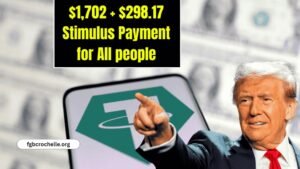Could a $1,600 stimulus payment be hitting bank accounts in July 2025? Rumors are swirling, sparking hope for millions struggling with rising costs. This article uncovers the truth behind the buzz, revealing who might qualify, when payments could arrive, and surprising twists you need to know. Read on to discover if you’re in line for this financial lifeline!
What Is the $1,600 Stimulus Payment?
The $1,600 stimulus payment rumor has taken the internet by storm. Social media posts and blogs claim it’s a new federal or state-led relief effort targeting Americans hit hard by inflation and high living costs. But is it real, or just clickbait? The truth lies in a mix of past programs and speculative proposals, with some states potentially stepping up where the federal government hasn’t.
The History of Stimulus Payments
Stimulus payments aren’t new. During the COVID-19 pandemic, the U.S. government issued three rounds of Economic Impact Payments:
- 2020: Up to $1,200 per adult, $500 per child (CARES Act).
- 2020: Up to $600 per adult, $600 per child (COVID-related Tax Relief Act).
- 2021: Up to $1,400 per individual, plus $1,400 per dependent (American Rescue Plan).
These payments helped millions weather unemployment and soaring costs. In 2025, the IRS is wrapping up unclaimed Recovery Rebate Credits from 2021, worth up to $1,400, with a filing deadline of April 15, 2025. Meanwhile, rumors of a new $1,600 stimulus payment stem from unverified sources, possibly tied to state-level programs or speculative federal proposals like the DOGE dividend.
Why This Payment Matters in 2025
With inflation still pinching wallets, a $1,600 stimulus payment could be a game-changer for low-income families, seniors, and single parents. Gas, groceries, and rent remain sky-high, making financial relief critical. While federal stimulus checks are unlikely, some states like Colorado and California are distributing surplus funds, offering hope for targeted aid in 2025. This payment could mean paying off debt, buying essentials, or building a small savings cushion.
How to Qualify and Get Paid
No official federal $1,600 stimulus payment has been confirmed for July 2025. However, some states are rolling out relief programs. Here’s a breakdown of potential eligibility and payment methods:
Eligibility Criteria
- Income Thresholds: Single filers earning up to $75,000, heads of household up to $112,500, or joint filers up to $150,000 may qualify for state programs like Colorado’s TABOR refunds.
- Tax Filing: File 2023 or 2024 state taxes to be eligible for state-specific payments.
- Residency: Must be a resident of the state offering the program.
- Social Security Number: A valid SSN is typically required.
- Dependents: Families may get extra funds (e.g., $500 per dependent).
Payment Methods
| Method | Timeline | Details |
|---|---|---|
| Direct Deposit | Mid-to-late July 2025 | Fastest; uses IRS or state tax records. |
| Paper Check | Late July–August 2025 | Mailed to address on file. |
| Prepaid Debit Card | July–August 2025 | For those without bank accounts. |
State-Specific Programs
| State | Payment Amount | Eligibility | Estimated Delivery |
|---|---|---|---|
| Colorado | Up to $1,600 | 2023 tax filers, income-based | Mid-2025 |
| California | Up to $725 | Low-to-moderate income residents | End of 2025 |
| New York | $300–$500 | Income up to $150,000 (single) | Autumn 2025 |
Shocking Facts About Stimulus Payments
- Unclaimed Funds: Over 1 million taxpayers missed out on $1,400 from 2021’s Recovery Rebate Credit, totaling $2.4 billion. The IRS is sending these automatically in 2025.
- State Surpluses: Colorado’s $1.5 billion surplus fuels its TABOR refunds, potentially up to $1,600 for joint filers.
- Scams Abound: Fake websites and emails promising stimulus payments are rampant. Always check IRS.gov for updates.
- Non-Taxable: Most stimulus payments, including state refunds, aren’t taxable and won’t affect federal benefits like SSI or SNAP.
Read More:
New Driving Rules for Seniors: Shocking Changes for Drivers in July 2025!
Goodbye to Retirement at 67: New age for collecting Social Security changes
Insider Tips to Maximize Your Chances
Want to ensure you don’t miss out? Here’s expert advice:
- File Taxes Early: Submit 2023 or 2024 returns to qualify for state programs or unclaimed Recovery Rebate Credits.
- Update IRS Records: Keep your address and bank details current on IRS.gov to avoid delays.
- Beware of Scams: Never share personal info via unsolicited calls or emails claiming to expedite payments.
- Check State Portals: Visit your state’s revenue department website for local stimulus payment updates.
- Use IRS Tools: The “Get My Payment” portal tracks federal payments, even for 2021 credits.
Frequently Asked Questions
Q: Is the $1,600 stimulus payment confirmed for July 2025?
A: No federal payment is confirmed. State programs like Colorado’s TABOR may offer similar amounts. Check state websites for updates.
Q: Who qualifies for state stimulus payments?
A: Typically, residents with incomes below $75,000 (single) or $150,000 (joint) who filed recent taxes.
Q: When will payments arrive?
A: State payments may start mid-2025, with direct deposits fastest (July 15–20) and checks later (July–August).
Q: Do I need to apply separately?
A: Usually no, if you’ve filed recent taxes. Some states may require applications—check locally.
Q: Are stimulus payments taxable?
A: No, most are non-taxable and won’t affect benefits like SNAP or SSI.
Conclusion
The $1,600 stimulus payment rumor for July 2025 has sparked excitement, but the truth is more complex. While no federal program is confirmed, state initiatives like Colorado’s TABOR refunds offer hope. By filing taxes, updating IRS records, and staying scam-savvy, you can position yourself for any relief. Don’t miss out—check your state’s revenue site and IRS.gov for updates. Share this article to help others stay informed, and let us know your thoughts in the comments!




